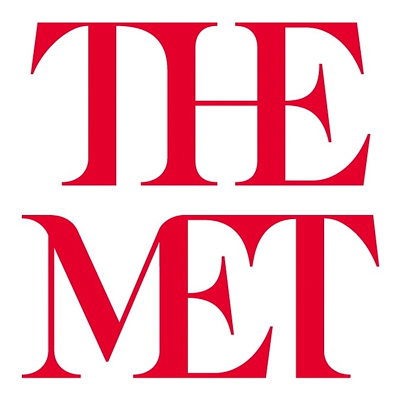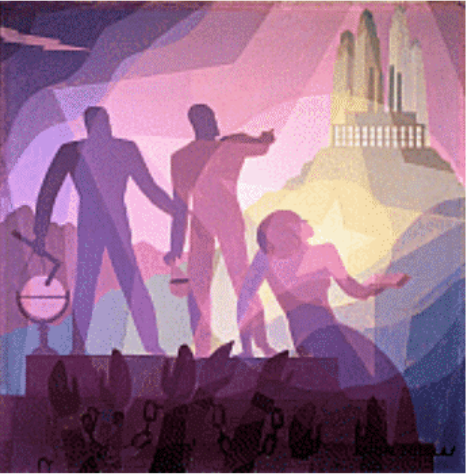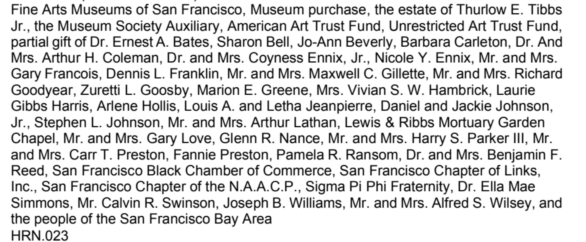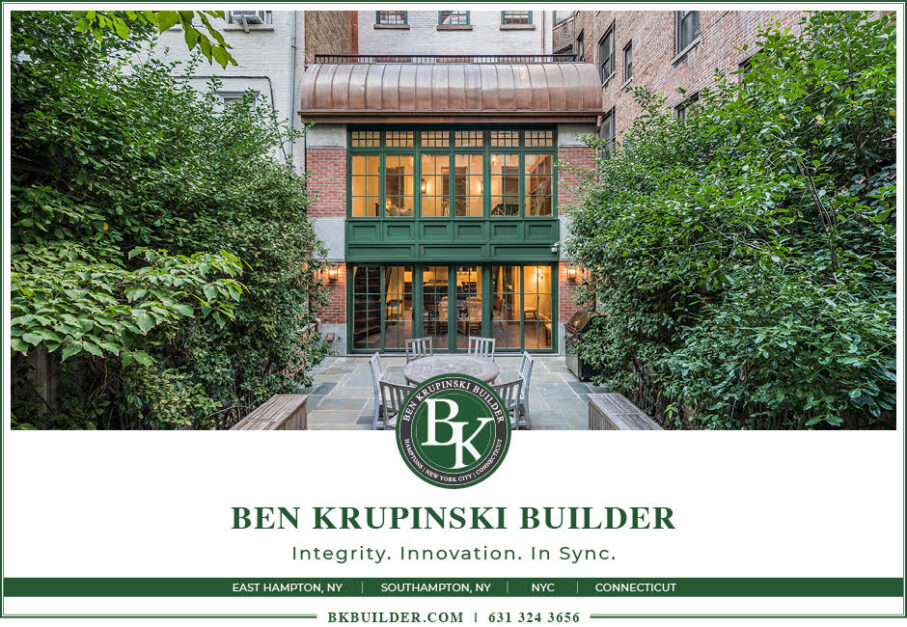 Met Exhibition to Present
Met Exhibition to Present
the Harlem Renaissance as the First African American– led Movement
of International Modern Art
——— The Met Fifth Avenue, Gallery 999 ———
~~~~~~~~~~~~~~~~~~
The Metropolitan Museum of Art will present the groundbreaking exhibition The Harlem Renaissance and Transatlantic Modernism from February 25 through July 28, 2024. Through some 160 works, it will explore the comprehensive and far-reaching ways in which Black artists portrayed everyday modern life in the new Black cities that took shape in the 1920s–40s in New York City’s Harlem and Chicago’s South Side and nationwide in the early decades of the Great Migration when millions of African Americans began to move away from the segregated rural South.
The first survey of the subject in New York City since 1987, the exhibition will establish the Harlem Renaissance as the first African American–led movement of international modern art and will situate Black artists and their radically new portrayals of the modern Black subject as central to our understanding of international modern art and modern life.
A significant percentage of the paintings, sculpture, and works on paper on view in the exhibition come from the extensive collections of Historically Black Colleges and Universities (HBCUs), including Clark Atlanta University Art Museum, Fisk University Galleries, Hampton University Art Museum, and Howard University Gallery of Art. Other major lenders include the Schomburg Center for Research in Black Culture, the Smithsonian American Art Museum, and the National Portrait Gallery, Washington, D.C. The exhibition will also include loans from significant private collections and European museums.
——————
“This landmark exhibition reframes the Harlem Renaissance, cementing its place as the first African American–led movement of international modern art,” said Max Hollein, The Met’s Marina Kellen French Director and CEO. “Through compelling portraits, vibrant city scenes, history paintings, depictions of early mass protests and activism, and dynamic portrayals of night life created by leading artists of the time, the exhibition boldly underscores the movement’s pivotal role in shaping the portrayal of the modern Black subject—and indeed the very fabric of early 20th-century modern art.”
——————
“We are very pleased to present this wide-ranging exhibition that establishes the New Negro cohort of African American artists and their allies—now known as the Harlem Renaissance—at the vanguard of the portrayal of modern Black life and culture in Harlem and other new Black cities nationwide at a time of rapid expansion in the first decades of the Great Migration,” added Denise Murrell, The Met’s Merryl H. and James S. Tisch Curator at Large. “Many New Negro artists spent extended periods abroad and joined the multiethnic artistic circles in Paris, London, and Northern Europe that shaped the development of international modern art. The exhibition underscores the essential role of the Harlem Renaissance and its radically new modes of portraying the modern Black subject as central to the development of transatlantic modern art.”
——————
“This landmark exhibition celebrates the brilliant and talented artists behind the groundbreaking cultural movement we now know as the Harlem Renaissance,” said Ford Foundation president Darren Walker. “I thank the dedicated team at The Met and applaud Denise Murrell for her vision and thoughtful curation of this vibrant collection of paintings, sculptures, film, and photography that gives a powerful glimpse into the Black experience in the early 20th century.”
——————

Aspiration, 1936, Oil on Canvas, by Aaron Douglas, American,
Topeka, Kansas 1899 – 1979. Source below.
————————
The Harlem Renaissance and Transatlantic Modernism will open with galleries that explore the cultural philosophy that gave shape to the New Negro movement of art and literature, as the period was known at inception, using a term defined and popularized by the movement’s founding philosopher, Howard University professor Alain Locke, in dialogue and debate with W.E.B. Du Bois, Charles S. Johnson, and influential literary and music figures including Zora Neale Hurston, Langston Hughes, and James Weldon Johnson. At the core of the exhibition are the artists who shared a commitment to depicting the modern Black subject in a radically modern way and to refusing the prevailing racist stereotypes.
Although united in their shared objective to portray all aspects of modern Black life and culture, individual New Negro artists developed widely varied representational styles, ranging from an engagement with African and Egyptian aesthetics and European avant-garde pictorial strategies to a commitment to classicized academic tradition. Featured artists include Charles Alston, Aaron Douglas, Meta Warrick Fuller, Palmer Hayden, Bert Hurley, William H. Johnson, Archibald Motley, Jr., Winold Reiss, Augusta Savage, James Van Der Zee, and Laura Wheeler Waring.
————
The Harlem Renaissance and Transatlantic Modernism
The exhibition will continue with galleries devoted to genre scenes and portraiture that capture all aspects of Black city life in the 1920s–40s as seen in vibrant paintings, sculpture, and film projections as well as photography from The Met’s recently acquired James Van Der Zee Archive and artists’ cover illustrations for books and periodicals, including the NAACP’s Crisis and the National Urban League’s Opportunity: A Journal of Negro Life. Monumentally scaled allegorical history paintings and portraits of luminaries will provide compelling vista views.
Galleries featuring paintings by New Negro artists who lived and worked in Europe during extended periods of expatriation will present their work in direct juxtaposition with portrayals of the international African diaspora by Black and white European artists including Henri Matisse, Edvard Munch, and Pablo Picasso, as well as Germaine Casse, Kees van Dongen, Jacob Epstein, and Ronald Moody.
The New Negro era’s fraught approach to social issues including queer identity, colorism and class tensions, and interracial relations will be the subject of a gallery featuring paintings, ephemera, and photography animated by film clips. The exhibition will conclude with an artist-as-activist gallery spotlighting artists’ treatment of social justice issues as the New Negro era comes to a close on the cusp of the 1950s civil rights movement. A coda will feature Romare Bearden’s 15-foot-wide series of collages, The Block (1970), from The Met collection, which evokes a town house row in mid-century Harlem and that sustains the legacy of the Harlem Renaissance.
In preparation for the exhibition, The Met undertook extensive archival research, original photography, technical imaging, and conservation treatment of important but seldom seen works of art. For example, archival research by the curatorial team resulted in the first-ever dating of two Laura Wheeler Waring portraits from her family’s collections: Girl with Pomegranate (ca. 1940) and Girl in Pink Dress (ca. 1927).
Funding for the conservation of five of the James Van Der Zee photographs included in the exhibition was provided through a grant from the Bank of America Art Conservation Project.
The Met has an extended history of collecting and displaying works by artists active during the Harlem Renaissance. In the 1940s, the Museum acquired several early works by gift from the Works Progress Administration (WPA), such as Jacob Lawrence’s Pool Parlor (1942) and Samuel Joseph Brown, Jr.’s Self-Portrait (ca. 1941). In 1969, the Museum presented the exhibition “Harlem on My Mind”: The Cultural Capital of Black America, 1900–1968, which was met with great controversy for excluding works of painting and sculpture by Black artists and instead presenting a social narrative of Harlem told through reproductions of newspaper clippings and photographs of prominent leaders and anonymous Harlem residents—in large-scale dioramas more similar to ethnographic or natural history museum displays than to art museum galleries. For the nearly 50 years since that exhibition, The Met has expanded its holdings of works produced during the Harlem Renaissance—notably in 2021 with the establishment of the James Van Der Zee Archive in partnership with the Studio Museum in Harlem—and through the acquisition of paintings including by Aaron Douglas, Elizabeth Catlett, and Charles Alston it continues to be an area of focus. The Harlem Renaissance and Transatlantic Modernism will provide an art and artist centered celebration and investigation into the Harlem Renaissance as a trailblazing, pivotal period within the art of the 20th century.
—————————-
Credits and Catalogue
The Harlem Renaissance and Transatlantic Modernism is organized by The Met’s Denise Murrell, PhD, Merryl H. and James S. Tisch Curator at Large, Office of the Director, in consultation with an advisory committee of leading scholars.
A fully illustrated scholarly catalogue on the vibrant history of the Harlem Renaissance will accompany the exhibition. It will feature essays that explore how the flow of ideas through Black artistic communities on both sides of the Atlantic contributed to international conversations around art, race, and identity while helping to define our notion of modernism. The catalogue is published by The Metropolitan Museum of Art and distributed by Yale University Press; it will be available for purchase from The Met Store.
The catalogue is made possible by the Mellon Foundation.
Additional support is provided by Denise Littlefield Sobel and Robert E. Holmes. Podcast and Programs
————————
The exhibition will be accompanied by a five-episode podcast—the first one created by The Met specifically for an exhibition. Hosted by writer and critic Jessica Lynne (a founding editor of the online journal ARTS.Black), it will also be the first in-depth podcast series devoted to the broader narrative of the Harlem Renaissance, and will explore questions of fashion, portraiture, leisure, and nightlife through the lens of music, literature, and art from the period. Special guests will provide diverse perspectives on the Harlem Renaissance and its continuing influence on global art and culture, including Robin Givhan, Pulitzer Prize-winning fashion writer/editor for the Washington Post; John Keene, National Book Award-winning poet, writer, and translator; Jordan Casteel, MacArthur-winning painter; Carl Phillips, Pulitzer Prize-winning poet; Christian McBride, Grammy-winning bassist; and several scholars, including Mary Schmidt Campbell, Bridget R. Cooks, Monica L. Miller, Richard J. Powell, and James Smalls.
The podcast is produced by The Met in collaboration with Audacy’s Pineapple Street Studios. It is supported by Bloomberg Philanthropies.
—————————–
 The Met will host a variety of exhibition-related educational and public programs, in addition to other opportunities that will engage the New York City community. As part of the Sight and Sound series, Leon Botstein and The Orchestra Now will perform the work of William Grant Still— considered to be the “Dean of African American Composers” and whose close ties with the Harlem Renaissance’s leading cultural figures cemented his place as a frontrunner of the movement (April 14 at 2pm). Jazz music from the era will also be performed live at Date Night at The Met on March 8 and 9 and April 26 and 27. On April 15, The Met will welcome families from Harlem to explore the The Harlem Renaissance and Transatlantic Modernism exhibition and other parts of the Museum after hours, with family-friendly activities and opportunities to speak to Met experts about the collection. Other family-and teen-focused programs will include activities at Museum Mile Festival (June 11), a Family Afternoon (July 14), Teen Fridays workshops (Spring), a weeklong Art Explore program for teens (Summer), and more.
The Met will host a variety of exhibition-related educational and public programs, in addition to other opportunities that will engage the New York City community. As part of the Sight and Sound series, Leon Botstein and The Orchestra Now will perform the work of William Grant Still— considered to be the “Dean of African American Composers” and whose close ties with the Harlem Renaissance’s leading cultural figures cemented his place as a frontrunner of the movement (April 14 at 2pm). Jazz music from the era will also be performed live at Date Night at The Met on March 8 and 9 and April 26 and 27. On April 15, The Met will welcome families from Harlem to explore the The Harlem Renaissance and Transatlantic Modernism exhibition and other parts of the Museum after hours, with family-friendly activities and opportunities to speak to Met experts about the collection. Other family-and teen-focused programs will include activities at Museum Mile Festival (June 11), a Family Afternoon (July 14), Teen Fridays workshops (Spring), a weeklong Art Explore program for teens (Summer), and more.
A symposium on April 27 will feature dynamic conversations, presentations, and performances by leading scholars, musicians, artists, and filmmakers engaging with themes in the exhibition; and an Educator Workshop for K-12 teachers will be held on June 7. Planned off-site activities include workshops in collaboration with partner cultural institutions and community organizations to provide multi-session art-marking experiences for Harlem communities, as well as Walking Tours in Harlem focused on different aspects of its history and culture. Current programming details can be found on The Met website, with further information forthcoming.
The exhibition is featured on The Met’s website as well as on social media.
————————————–
Aspiration by Aaron Douglas

========================================================
AAQ / Resource: Ben Krupinski Builder
______________________________________________________________

